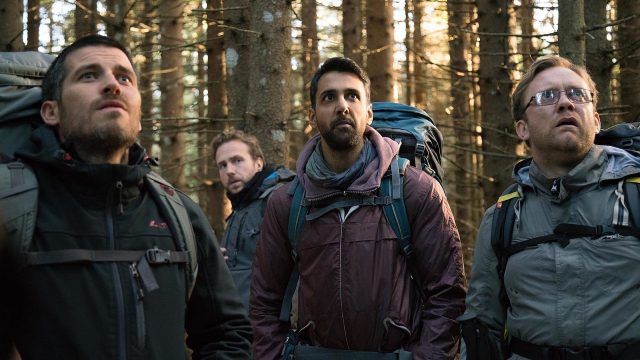David Bruckner’s The Ritual, like The Conjuring, manages the feat of the new horror classicism: it’s so traditional, and so traditionally satisfying, that it’s possible to predict almost every move of it, but it’s also genuinely scary. We usually think of horror coming from the fear of the unknown, but there’s a real space in the genre for the dread of what you know is coming, for the inevitable catastrophe imagined in exquisite detail and lived out in a blur.
So: four men go into a primordial forest in Sweden. They’re old friends whose social bonds have been fraying for a while now, and now–though no one’s admitting it yet–they’ve snapped: the peacemaker of the group was murdered in a convenience store hold-up, and everyone not-so-secretly blames the group’s suave asshole. It was his idea to go into the store for one more bottle of vodka, he was the one who asked for company, and he got out of the hold-up without, as one character puts it, a drop of blood on him. He survived because he hid. That he almost certainly wouldn’t have survived if he’d done anything else–that his position was terrible, that he was armed with a bottle against two men with machetes–doesn’t matter to the friends who, you suspect, would have quietly preferred if he’d been the one to die instead. It doesn’t matter to him either, and past the opening, where all this happens, the suave asshole isn’t a suave asshole at all but a jumpy, haunted man burdened with PTSD and guilt.
That’s Luke, well-played by Rafe Spall, and he’s joined by his friends Dom (Sam Troughton), Phil (Arsher Ali), and Hutch (Robert James-Collier): they’re making the hiking trip Rob wanted them to go on. The trip is a kind of memorial for him–they build a little monument in his honor–and it would be easy to believe that this is the last time they’ll all be together, now that “the best of them” is gone.
Then Dom hurts his knee, and they decide to take a shortcut back to the lodge. One of the film’s strengths is a strong, quotable screenplay that’s psychologically deft and often witty–it crafts characters who feel aware of their ominous situation, if not not of their genre (another well-threaded needle)–and so it features an apt response to this: “If the shortcut was a shortcut, it wouldn’t be called a shortcut, it would be called a route.”
Needless to say, their detour through the woods isn’t as quick as they thought, and it brings them face-to-face with an abandoned cabin (“Clearly this is the building we’ll all be murdered in”), ancient runes, an elk hung up in a tree, and various nightmares, hallucinations, and escalating psychological traumas that keep apace of the group’s rapidly deteriorating mood. It’s like The Blair Witch Project or like The Descent. Like Underwater, which I also enjoyed, it’s admittedly like a lot of things. This is no-frills folk horror where the director’s only ambition is to execute all the elements as well as possible, and it succeeds on its own terms and features some unusually good creature design in the bargain.

